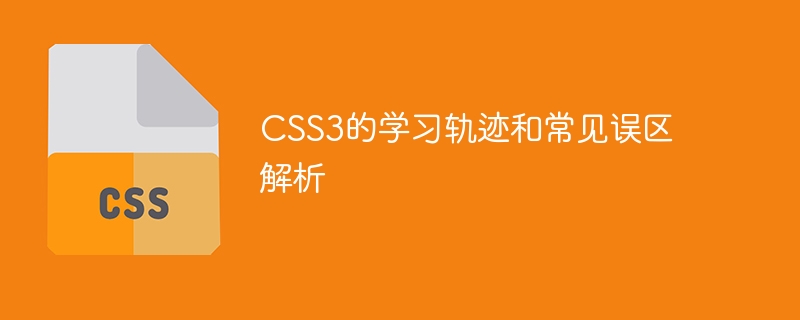Home >Web Front-end >CSS Tutorial >CSS3 learning trajectory and analysis of common misunderstandings
CSS3 learning trajectory and analysis of common misunderstandings
- PHPzOriginal
- 2023-09-08 08:46:42656browse

CSS3 learning trajectory and analysis of common misunderstandings
Introduction:
With the continuous development of Web technology, CSS3 has become one of the necessary skills for front-end engineers one. By mastering the various functions and special effects of CSS3, we can create more colorful web page layouts and interactive effects. This article will introduce the learning trajectory of CSS3, analyze some common misunderstandings, and provide some code examples.
1. Learning track:
1. Master basic syntax:
Understanding the basic syntax of CSS3 is the first step to get started. Describe styles through selectors, attributes, and values, and learn how to apply styles to HTML elements.
Sample code:
<!DOCTYPE html>
<html>
<head>
<style>
h1 {
color: red;
font-size: 24px;
text-align: center;
}
</style>
</head>
<body>
<h1>Hello, CSS3</h1>
</body>
</html>2. Learn common layout methods:
Learn how to use CSS3 to implement common layout methods, such as box model, floating, positioning, etc. Mastering these layout methods can achieve flexible layout and responsive design of web pages. At the same time, familiarity with Flexbox layout can help us implement complex layouts more easily.
Sample code:
<!DOCTYPE html>
<html>
<head>
<style>
.container {
display: flex;
justify-content: center;
align-items: center;
}
.item {
flex: 1;
text-align: center;
background-color: lightblue;
margin: 10px;
padding: 10px;
}
</style>
</head>
<body>
<div class="container">
<div class="item">1</div>
<div class="item">2</div>
<div class="item">3</div>
</div>
</body>
</html>3. Apply transition and animation effects:
Mastering how to use the transition and animation functions of CSS3 can add more vivid interactive effects to web pages. Understand the usage of properties, values and key frames of transitions and animations, and use JavaScript to achieve more complex interactive effects.
Sample code:
<!DOCTYPE html>
<html>
<head>
<style>
.box {
width: 100px;
height: 100px;
background-color: red;
transition: width 2s, height 2s;
}
.box:hover {
width: 200px;
height: 200px;
}
@keyframes rotate {
from {
transform: rotate(0deg);
}
to {
transform: rotate(360deg);
}
}
.circle {
width: 100px;
height: 100px;
background-color: blue;
animation: rotate 5s infinite;
}
</style>
</head>
<body>
<div class="box"></div>
<div class="circle"></div>
</body>
</html>2. Analysis of common misunderstandings:
1. Not fully understanding the compatibility issues of CSS3:
Some features of CSS3 are not available in older versions may not be fully supported in your browser, so when using CSS3, you need to consider browser compatibility. You can use methods such as CSS prefixes and media queries to solve compatibility issues, and you can also use tool libraries such as polyfill.
2. Excessive use of special effects and animations:
Special effects and animations can add some highlights to the web page, but excessive use will make the web page too fancy and affect the user experience. When using special effects and animations, you need to make choices based on actual needs to avoid over-design.
3. Inadequacy of code reuse:
CSS3 provides many features that facilitate code reuse, such as classes, pseudo-classes, and pseudo-elements. Proper use of these features can improve development efficiency and code maintainability.
Conclusion:
By mastering the basic syntax, common layout methods, special effects and other functions of CSS3, we can create a rich and colorful web interface. However, you need to pay attention to CSS3 compatibility issues, reasonable use of special effects and animations, and full utilization of code reuse. In summary, if you master the learning trajectory of CSS3 and avoid common misunderstandings, you will be able to better apply CSS3 to achieve more elegant and efficient web design.
Reference materials:
- MDN Web documentation: https://developer.mozilla.org
- w3school: https://www.w3school.com.cn
(Note: The above sample code is only to demonstrate the function and usage, not a complete, runnable code.)
The above is the detailed content of CSS3 learning trajectory and analysis of common misunderstandings. For more information, please follow other related articles on the PHP Chinese website!

